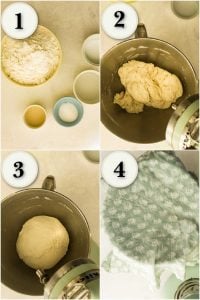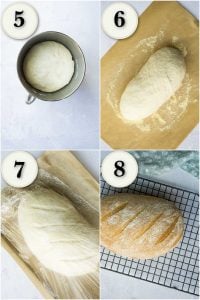Rustic French Bread
An easy to make rustic loaf with a crisp crust. With its soft crumb, this loaf slices easily for delicious sandwiches or to serve with dinner.
Equipment
- Bread machine (optional)
- Stand mixer with a dough hook (optional)
- Large mixing bowl
- Baking Sheet
- Damp tea towel
- Wire cooling rack
Ingredients
- 4 cups all purpose flour or bread flour (bread flour will require a higher amount of water)
- 1½-1¾ cups water (for the dough)
- 1 teaspoon water (for creating steam before baking)
- 2 teaspoons salt
- 2 teaspoons instant yeast
- cornmeal for bottom of the pan
Instructions
- Mix the dough. Combine the flour, yeast, salt, and less water (1½ cups). Mix until well combined. If the dough seems dry, add more water and a teaspoon until you get a soft, smooth dough. You can mix by hand, using a stand mixer with a dough hook, or in a bread machine using the dough cycle.
- Knead the dough. Knead the dough for 7-12 minutes, or longer if kneading by hand. The dough should become elastic and smooth. If it sticks to the sides of the bowl, add flour a teaspoon at a time. If it is too dry, add more water by a teaspoon. The dough is ready when you can stretch it thin enough to see translucent areas without tearing (windowpane test).

- First rise. Gently shape the dough into a ball and place it in a clean, lightly oiled bowl. Then, cover the bowl with a damp tea towel and place it in a warm area (90°F or 32°C is perfect) to rise until puffy and doubled in size, about 1 hour.
- Shape the loaf. After the first rise, gently remove the dough from the bowl and shape it into an oval loaf. There is no need to flatten it beforehand; shape it. Next, place the shaped loaf on a parchment-lined baking sheet sprinkled with cornmeal. Lightly rub the top with flour and slash the loaf with a sharp knife to create shallow cuts.
- Second rise. Cover the loaf with plastic wrap sprayed generously with cooking spray to prevent sticking. Place the loaf in a warm spot to rise until puffy and doubled in size, about 45 minutes.

- Preheat the oven. Preheat the oven to 400°F (200°C) towards the end of the second rise. Place an empty, rimmed baking sheet on the lower oven rack and allow it to preheat.
- Create the steam and bake. Before placing the loaf in the oven, pour 1 cup of boiling water onto the preheated baking sheet to create steam. Carefully place the bread in the oven and bake for 40 minutes, or until the loaf is golden brown and sounds hollow when tapped on the bottom.
- Cool and slice. Remove the loaf from the oven and cool it on a wire rack for at least 30 minutes before slicing for the best results.
Notes
Make sure the water is not too hot or too cold for the yeast. You want it just warm, around 100-110°F. If you don’t have a thermometer, it should feel warm but not hot.
If the dough is sticky, sprinkle a little flour on your hands and the counter. But don’t mix too much flour into the dough; it can make it heavy. The dough should be soft but not too hard to handle.
Before you shape the dough, tossing a little flour on top can make it look nice and keep it from sticking to your hands or cling film.
When shaping the dough, be gentle so you don’t push out all the air. You want to keep it airy for a light, fluffy bread. Just shape it carefully into a loaf shape.
Even if the top is golden, check if the bread is done by tapping the bottom. It should sound empty. If it doesn’t, bake it a bit longer.
It’s hard to wait, but let the bread cool down before cutting. This way, it sets inside, and you can slice it nicely without it tearing.
Nutrition
Calories: 239kcal | Carbohydrates: 49g | Protein: 8g | Fat: 1g | Saturated Fat: 1g | Sodium: 584mg | Potassium: 96mg | Fiber: 2g | Sugar: 1g | Calcium: 9mg | Iron: 3mg
Servings: 8 slices
Calories: 239kcal